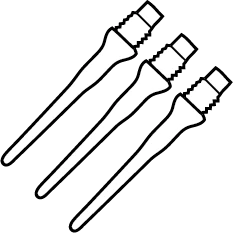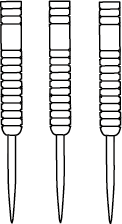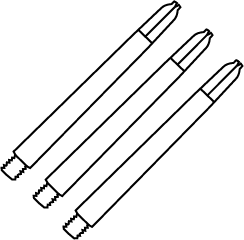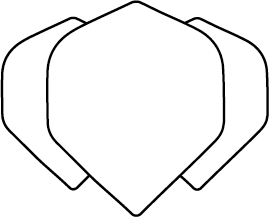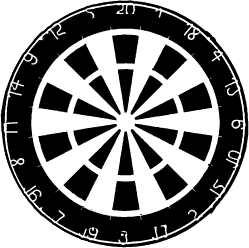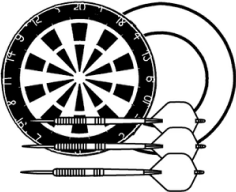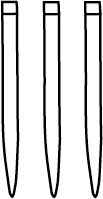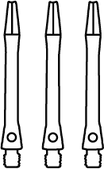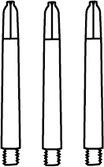
Lukas ist Dart Fan der ersten Stunde und seit über 10 Jahren passionierter Dartspieler. Spätestens nach dem Besuch der Darts WM 2016 im ehrwürdigen Alexandra Palace mit seinem späteren Co-Founder und damaligen WG-Partner Timm war für ihn klar: Darts muss auch in Deutschland größer und bekannter werden. Mit myDartpfeil und dem weltweit einzigartigen Dartpfeil Konfigurator kann sich jeder Dartspieler - von Anfänger bis Profi - seine eigenen, perfekten Dartpfeile zusammenstellen und individuell gestalten.
Although more and more people in Germany are using darts, the exact dart rules are still unclear for many people. Today we will explain to you briefly and concisely what exactly playing darts is about and what you have to pay attention to.
The sport of darts has a very long history , dating back to the Middle Ages in England and the rules of darts have often changed accordingly. Today's dart rules - as we all know them - have their origins at the beginning of this century. The five most important points first:
- Each player has three arrows in his hand and therefore three throws
- Only arrows that remain stuck in the board after the last of the three throws are counted
- Most tournaments count backwards from 501 or 301 points
- The players' goal is to get to zero as quickly as possible
- The professionals usually play with “double out” , for beginners we recommend the “straight out” variant (no matter how to get to zero)
Game preparation: dartboard, distance, height & dimensions
In order to be able to throw the first darts and start playing, certain game preparations must be made. There are a few dart rules and dart dimensions to consider.

dartboard
First of all, we will deal with the dartboard or the dart board onto which the darts are thrown. It doesn't matter whether the dartboard is thrown at an electronic dartboard (such as the CB 90) or a classic dartboard (such as the Blade5).
All dartboards are divided into 20 equally sized segments , which are assigned the numbers from 1-20 . The numbers are mixed up, so that mostly large and small numbers follow each other alternately. The highest value, 20, is always at the top in the middle.
All segments are crossed by two narrow rings . The outer of the two rings is the so-called double segment and surrounds the disc on its outer edge.
A hit in the double segment doubles the value of the respective segment. A small ring runs through the disk towards the inside of the disk. Here we are talking about the so-called triple segment , which triples the value. The maximum number of points per throw is the triple 20, i.e. 60 points.
There are also two other fields in the center of the dartboard: the green single bull (counts 25 points) and the red bull's eye (counts 50 points).
Infobox: The bull's eye has a diameter of 1.27 centimeters, the single bull 3.18 centimeters.
The other dartboard dimensions are as follows. The value range of the disc, i.e. the area covered by the double ring, has a diameter of 34 centimeters. The entire disc, however, has a diameter of 45.1 centimeters.

Distance and height
After we have familiarized ourselves with the scoring system on the dartboard, let's take a look at the dimensions and distance of darts .
These have changed significantly in recent years, especially for e-darts (=playing on electronic dartboards), so that almost uniform rules now apply to the entire sport of darts.
Only the dartboard height is different : the classic dartboard is attached to the wall so that the bulls-eye hangs at a height of 1.73 meters. With the e-dart, the dartboard height is 1.72 meters.
We particularly recommend protecting the wall behind the dartboard as well as the floor within the playing area. This is especially true when playing with steel darts - i.e. darts that have an iron tip .
There are ready-made back walls for the dartboards, so-called surrounds , as you can see in use at the World Cup, for example.
Now let's come to the dart distance: The distance from the front of the dartboard to the throwing line - also called the oche - is 2.37 meters for all variants .
It is advisable to play with attached throw markers in order to maintain the dart distance. This means no player can transgress. There are now even specially produced dart mats or small lasers that project a launch line at the push of a button .

Dimensions
Now that the dartboard is hanging in the right place, all we have to worry about is the right darts. Buying the perfect darts is a science in itself, especially for beginners and newcomers to darts.
The following general conditions only apply: With steel darts, only arrows that are a maximum of 30.5 centimeters long and weigh 50 grams may be used. In e-dart tournaments where players aim at an electronic dartboard, the soft darts may be a maximum of 16.8 centimeters long and weigh 20 grams, depending on the dart machine.
Now that all the preparations have been made, the dart throwing can finally begin: Game On!

Game play: Basic dart rules, game mode, arithmetic
Now let's start with the basic rules of darts. As already mentioned above, each player must stand behind the oche, i.e. the throwing line, when making a throw.
If the player stands far to the right or left of the line, the position must be behind an imaginary extension of the oche . When throwing, at least one of the player's legs must always touch the ground .
At the start, each player has three arrows in their hand and therefore three throws for each shot. Of course, the darts have to be thrown onto the target individually and immediately after each other.
In theory, each player has a maximum of one minute for a throw, i.e. he can take a maximum of three minutes for each shot (= three throws).
In practice, however, this time is usually never used up; most players need a maximum of 30 seconds for their recording .
Any dart that falls or bounces off the board (=bouncer) will not be counted. Only arrows that remain stuck in the board after the last of the three throws are counted.
The darts must be removed from the board after the score has been recorded and announced by the referee. To prevent these bouncers, steel tips with a non-slip surface are particularly helpful.
It may even happen that a player aims so precisely that he throws his arrow into a dart that is already stuck . Then one speaks of a so-called “Robin Hood”. This throw looks very spectacular, but only the one arrow that is stuck in the board counts.

Game mode
Now that we have familiarized ourselves with the basic processes, let's move on to the most common game modes . Depending on the tournament mode, 501, 301 or cricket are mainly played. The classic dart game is 501 Double Out .
An initial value of 501 points per round (=Leg) applies. The goal now is to reduce the score from 501 to exactly zero as quickly as possible .
The players take turns throwing three darts. The points of the fields hit by the player are deducted from the remaining points. The player who can bring his score to zero first wins the leg.
In order to end the game or get exactly zero points, this must be done by throwing on a double field (outer ring) or the bulls eye. For example, if there are 40 points left, the player can win the round by playing double 20 (=D20).
The highest possible score that you can check (throw to zero) with three darts is 170 points . For many starting scores there are different ways to roll to zero. That's why there are so-called checkout tables in which you can quickly see which fields you need to win.
If the player scores a higher number of points than necessary , he has folded . This is considered a “no score”: the shot is not counted and it is the opponent’s turn again. When it is the turn of the player who threw over again, he starts again with his starting point number before his last throw.
Calculate
In order to prevent this, it is very important to master the basics of arithmetic , especially in the 501 Double Out game mode. Most players will probably remember the small 1×1 from dark mathematics lessons, but the fun stops at the big 1×1.
Correct and fast arithmetic can be just as important as mastering the rules of darts.

At major darts tournaments on the worldwide stages of the PDC (=Professional Darts Corporation) and the BDO (=British Darts Organization), so-called callers are used .
A caller adds up the score of the recording in a fraction of a second and then announces it loudly to the audience . The legendary “onehundredandeightyyyyy” announcements at the Darts World Championship in Alexandra Palace are probably present in every darts fan’s ear.
But not all of us have the skills of a caller. Until you are able to not only add up the shot (i.e. the three darts thrown) in a few seconds, but also subtract from the rest, for example with the 501 Double Out - that definitely takes a very long time.
Calculation aids
For newcomers to the sport, the following applies: first finish the throw , then add it up . Otherwise you'll lose your concentration very quickly .
It's easiest to start with a pen and piece of paper . In other words, write 501 upwards as the starting value and subtract the points thrown below it, round by round. It makes sense to do this like in school: first the ONE, then the TEN!
Example: If, for example, the starting value is 501 and you roll 26 points (this could happen more often in the beginning), you first subtract six points and get 495 points. Then you subtract the remaining 20 points and finally get 475 Points.
Even if it may be a bit difficult at the beginning, you should be aware that the players on TV and all other experienced dart players often no longer consciously calculate. Through years of practice, they have practically all the subtractions of the most commonly thrown combinations in their heads!
But we also have a solution for the very lazy computers among us: the Dartcounter app ! Here you just have to add up your three hits and then enter them into the app .
This then automatically deducts the points you have thrown from your current score and also shows possible checkout options in the finish area (see table above).
Other darts games: “Straight Out”, “Double In”, “Around the Clock” & Co
Especially when starting out in darts, the 501 DO game mode can cause boredom relatively quickly. In particular, trying to end the game with a double field is often very difficult at the beginning and quickly leads to resignation .
Straight out
The variant of ending the game with “Double Out” is the most popular variant among experienced dart players and also the best known variant thanks to TV, but there are also numerous other options.
As already explained before, with “Double Out” you need a hit in the double ring to finish, i.e. end and win a round of darts.
There is also the “Master Out” version: The game can be ended with a “triple” throw or a “double” throw. With a “Straight Out” you can throw any field to end the game as long as it brings the player to zero points.
For beginners, it is particularly recommended to start with this variant and later adapt the game to the correct dart rules.
Double in
However, there are also game variants in which you have to hit a given field at the start of the game. With “Double In” any double field must be hit before the points can be counted down.
The “double” thrown is deducted from the score. With “Triple In”, on the other hand, you have to start with a hit in a triple field, only from then on do the points scored (including the triple thrown) count.

Around the Clock & many more
There are many other game modes on the dartboard. These include well-known dart games such as “Cricket” or “Around the Clock”, which can be found on every standardized dart machine .
The game “Around the Clock” is particularly suitable for beginners , as it increases accuracy on individual segments of the dartboard.
The aim of the game is to match all the numbers once, one after the other in a clockwise direction - starting with “1”. The winner is the person who lands a hit on the “20” first.
It is irrelevant whether the player hits a single, double or triple segment. After the segment “1” has been hit, the next dart is immediately aimed at “18”, then at “4”, etc.
There are also countless variations of this game, for example with Bull or hitting the numbers from 1 – 20 in numerical order, i.e. first “1”, then “2”, “3” etc.
There are also other more exotic dart games, such as “Darts 4 in a row” or “Darts Kniffel”.
Ready to take your skills to a new level? Discover our exclusive secrets and proven methods to optimize your game:
- Dart double training : All secrets revealed: This is how you become a double professional. Find out and train now. Click here » including free professional tips
- Killer darts for beginners and professionals. Discover proven strategies that will lead you to victory. Click in now and play successfully! including insider tip!
- Better darts through solo training: Dart training games alone . Suitable for all performance classes. Find out now and always throw accurately!





